If you’re trying to eat more Omega-3, there are a couple of things you can do:
- Eat more seafood like salmon, sardines, mackerel etc.
- Take Omega-3 supplements
If you don’t like seafood or don’t like popping pills, then you’re left with only one choice: eating Omega-3 foods – foods that are naturally rich in Omega-3 or have been supplemented with Omega-3.
If you’re wondering why I did not mention Flax or Chia as a source of Omega-3, check out my earlier post on Flaxseed oil vs fish oil. They are almost useless as a source of EPA & DHA Omega-3, which are the two types of Omega-3 you need.
In this series I’ll review foods that scream ‘Omega-3’ on their label. If I don’t get to some of your favorite foods, drop me a note or send me a sample – my grocery store doesn’t carry all the Omega-3 foods on the market.
Some Omega-3 foods are totally useless marketing gimmicks. Others are worth the added cost.
Omega-3 Foods Focus: Omega-3 Eggs
All eggs used to be Omega-3 eggs a hundred years ago, when chickens were allowed to roam the yard, foraging and pecking at leaves and grubs. Those chickens didn’t lay eggs every day, but when they did, their eggs were full of Omega-3.
Chickens put Omega-3 into their eggs for the same reason that human breast milk has DHA Omega-3 – to give the next generation an essential nutrient to grow and remain healthy.
But those days are long gone.
Now, eggs are mass-produced in giant factories where the chicken do nothing but eat feed made with corn and soy.
Corn and Soy are calorie-dense but poor in Omega-3.
Garbage in. Garbage out.
Since the mass-production of eggs began, eggs have seen their Omega-3 levels plummet and Omega-6 levels rise dramatically.
So today’s mass produced eggs have only about 35 mg of Omega-3 and about 700 mg of Omega-6.
Ideally, you want equal parts of Omega-3 and Omega-6 in your diet.
Eating 20 times more Omega-6 is not just dangerous, but deadly.
Too much Omega-6 equals more heart attacks.
Simple as that.
Too much Omega-6 also causes several other serious health issues. So whatever you eat, make sure it does not contain Omega-6 rich oils like corn oil, vegetable oil (soy), sunflower oil or safflower oil. Use Olive or Coconut oil instead.
By now, you’re probably thinking: is there a lot of cholesterol in eggs that I should be worrying about?
Answer is, no. Despite the cholesterol, eating eggs has never been convincingly linked to poor heart health.
What’s an Omega-3 egg?
Omega-3 eggs are produced by hens fed a special vegetarian diet of plant material, grains, flaxseed and sometimes, even seaweed. While humans cannot efficiently convert the Omega-3 found in Flaxseed into usable forms, chickens surely can!
Flaxseed is one of the richest plant sources of omega-3.
Some new Omega-3 egg manufacturers have patented chicken feed that produces eggs with super high levels of Omega-3.
Not just that, they have lower levels of Omega-6.
It’s a win-win.
Omega-3 eggs usually have 4 times more omega-3 than regular eggs.
But patented chicken feed formulas like the one used by Christopher Eggs, have 20 varieties of vegetables. They say their feed mimics what chickens have chosen to eat for centuries. Back to basics!
Whatever the secret sauce, their eggs have 18 times more Omega-3 than regular eggs.
Each Christopher Egg has 660 mg of Omega-3! They claim to have the most Omega-3 per egg.
Omega-3 eggs are also low in other saturated and trans fats, which makes the good news even better.
Pasture, Free-range and Organic Eggs
Pasture eggs are ideal. They’re better than Omega-3 eggs.
With Pasture Eggs, chickens are allowed to wander about and eat what they want. This makes for great quality eggs with nice orangey yolks in the summer.
But pasture eggs are very hard to find.
Don’t confuse ‘Free range’ eggs with ‘Pasture.’
Free range eggs are the same unhealthy eggs as regular eggs, except these chickens have the freedom to wander about and may be get some sunshine. By USDA regulation, ‘allowed access to the outside’ is considered ‘free range.’ This usually means a tiny door is set open somewhere in the factory. The chickens may never see sunshine if they don’t figure out where this door is.
Click here for a report on Organic Eggs from the Cornucopia Institute.
Free range chickens are fed the same corn and soy feeds as regular chickens. So stay away from them even if they say ‘Organic Free Range.’ While that sounds healthy, it is not! The chickens doing the laying may be happier and freer but your health won’t be any better.
Free range eggs are not pasture eggs.
Omega-3 eggs are not pasture eggs.
Pasture eggs are the best but Omega-3 eggs are the next best things.
Additional Reading:
The Baltimore Sun newspaper had an article worth reading: Enriched eggs, milk may not be best source for omega-3s
Omega-3 Foods – Marketing Gimmicks
Look for HOW MUCH Omega-3 is in each egg.
This is very important.
Some Omega-3 eggs have mostly ALA Omega-3. ALA makes for great window-dressing but does not provide the health benefits of EPA and DHA Omega-3 (the kind in fish.)
Smart Balance is an example. Sure, it has Omega-3 blasted over its label. But it has only 32 mg of DHA Omega-3. You’d have to take 10 eggs to equal a regular fish oil pill. And you’d have to take 30 eggs to equal the Omega-3 in one Ultra-concentrated fish oil like OmegaVia.*
There are many innocent consumers like this person or this person who think they’ve given their body enough Omega-3 for the day by eating a Smart Balance egg.
Omega-3 eggs are a step in the right direction, but it is NOT a one-and-done quick fix. Your body needs a LOT more Omega-3 than what is found in one Smart Balance egg.
Good, honest eggs manufacturers say how much DHA Omega-3 is in each egg. Higher the better. Even Christopher Eggs, who claim to have 660 mg of Omega-3 per egg has only 100 mg of EPA and DHA Omega-3. Those are the Omega-3s that make you healthier.
How much is 100 mg of EPA + DHA? That’s a third of a regular fish oil pill. Or a tenth of a pill like OmegaVia.
So, which one to buy?
My choices are:
Christopher Eggs – these seem to have the highest amount of Omega-3 per egg but are not available everywhere.
Skagit River Ranch – if you’re lucky enough to live in the Seattle area, you can buy their eggs at a few places. They’re worth looking for.
Land O Lakes Omega-3 Eggs – sold nationwide. It has 350 mg of Omega-3 but they don’t say what kind, so I feel luke warm about it. But the yolks are nice and orange!
I also buy Trader Joes Omega-3 eggs, which have 75 mg of DHA Omega-3 per egg. That’s higher than most Omega-3 eggs. At $3.99 a dozen, it’s not too pricey either. They actually mention that they feed their chickens flaxseeds! Way to go, Trader Joes!
Other Gimmicks to Watch out for:
- “Vegetarian fed” – Sounds nice but means nothing. Stuffing a chicken with corn and soy is not a good thing.
- Serving size = 2 eggs. Serving size should be for 1 egg.
- No DHA or EPA amount – brands with no mention of DHA levels on the package.
My part in Egg History… |
I needed a job. The year was 1986 and I was a wet behind the ears freshman at Purdue University.”What do you know about poultry?” asked Dr. William Stadelman, a Professor of Poultry Science, during the interview. Poultry?! Heck, I better make something up quickly! I need this job. What the heck am I doing in the Poultry Science building? I’m a Biomedical Engineering student. I don’t care about poultry! “Sir, my grandma had a bunch of chickens on her farm. And I’d feed ’em in the morning and steal their eggs in the afternoon. I did that every day for an entire summer.” All of that was true. Whew! Apparently, that was more experience than what the city kids from Chicago had. So I got the job. He’d literally written the text book used by most universities. His students ran Tyson, Butterball and Jenny-O. He’d written over 230 scientific papers on eggs. Ok, so he could tell a rooster from a hen. My first project working with him was to conduct taste tests on something called “Omega-3 eggs.” Sounded Star-trekky. He’d been working with the egg industry to increase the Omega-3 content of eggs by adding fish oil and fish meal into chicken feed. And he wanted to find out if these new, fancy Omega-3 eggs would taste funny. So it was my job to find hundreds of volunteers and give them three small plates of scrambled eggs. One plate had regular eggs and the other two were Omega-3 eggs. They had to pick the odd one. It’s called a Triangle Test. I am a Biomedical Engineering student, dammit! What am I doing scrambling eggs for 4-bucks-an-hour? I’m a loser. By this time, I’d also realized that I was a math moron. I stunk at Calculus and Differential Equations. My dreams of designing an artificial heart with my biomedical engineering degree went poof. But I was really getting into this Omega-3 thing… And the rest is history. Dr. Stadelman passed away in 2007 at the age of 90. He was known as the ‘Father of Poultry Science.’ You are missed, Doc. |
Next Omega-3 Foods Review Coming up: JIF Omega-3 Peanut Butter.
* These statements have not been evaluated by the Food and Drug Administration. This product is not intended to diagnose, treat, cure, or prevent any disease.
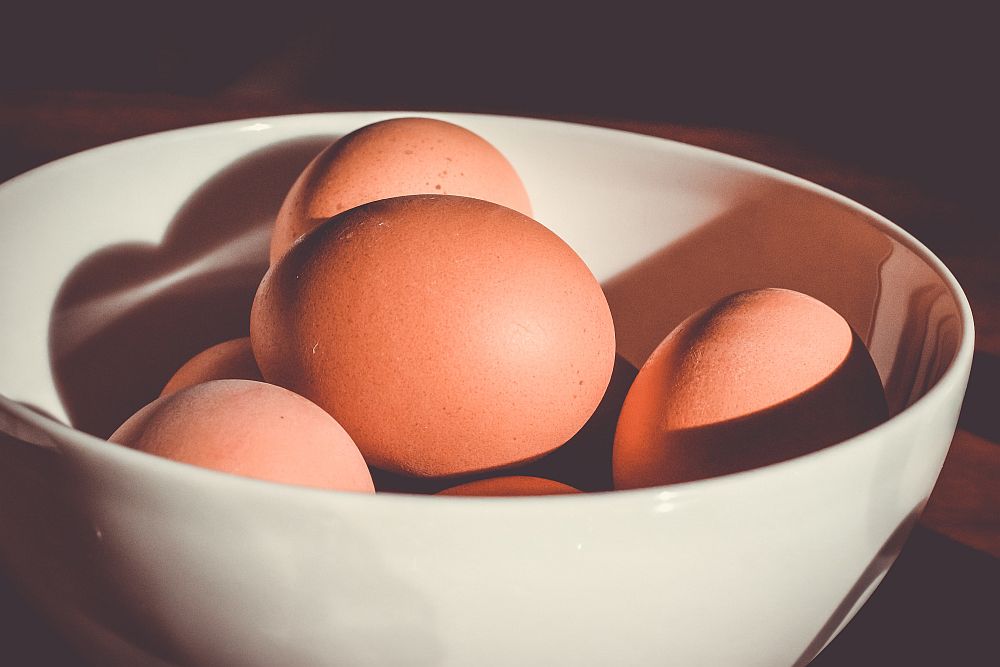
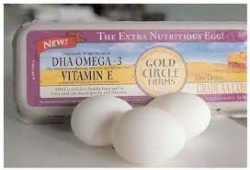



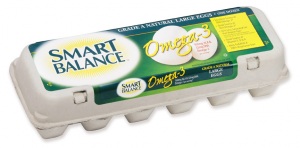
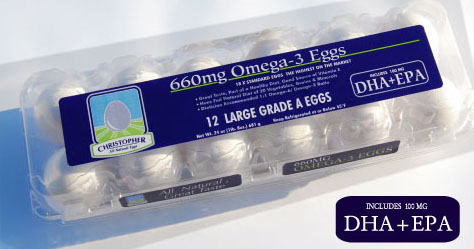

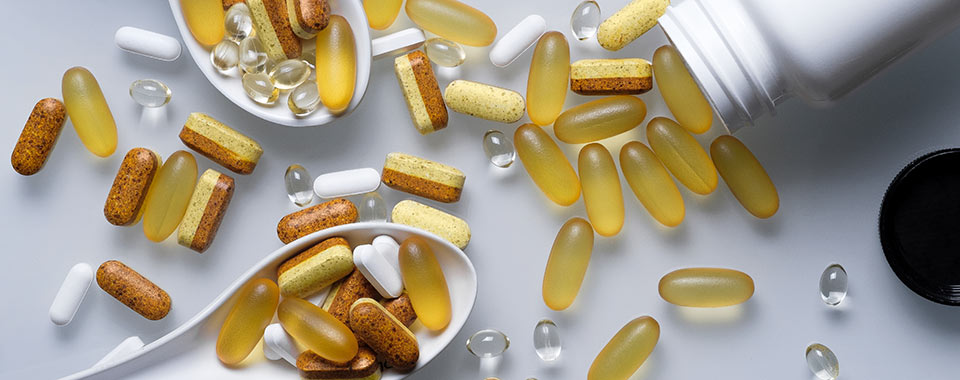

Christopher eggs with good omega 3’s in them are also great for reducing body fat, I use them to cut up for photoshoots and the difference is fantastic. Never buy anything but omega 3 eggs in my opinion.
On this subject, I just read Dr Mercola’s article (http://articles.mercola.com/sites/articles/archive/2012/03/19/caged-vs-free-range-chicken-eggs.aspx?e_cid=20120319_DNL_art_1), the Cornucopia Institute’s egg scorecard (http://www.cornucopia.org/2010/09/organic-egg-report-and-scorecard/), and this one. Even though I have been eating Christopher eggs for years when I can find them, I am beginning to feel I should get my own chickens.
If you live in a rural area and have to room to raise your own egg-layers, then fantastic! Go for it! Pastured chickens that live forage under the sun, eating leaves, bugs, grasses and seeds will produce very healthy eggs. The problem with eggs from caged birds (besides ethical issues) is that they’re fed soy and corn based diets, which drive up the Omega-6 content (bad!) and drive down the Omega-3 content (also bad!). Buying organic, cage-free, Omega-3 eggs will still not solve the high-Omega-6 issue with eggs. The only way to get around that problem is to let chickens be chickens – let them run around and eat natural foods and not soy-based feeds. An egg-farmer friend of mine says chickens won’t lay as much if you let them fend for themselves. Tough spot to be in. I will not stop eating yolks – they contain way too many essential nutrients that I can’t find elsewhere. So my approach is to drastically cut down on Omega-6 in the rest of my diet, so eggs and a few nuts have become my only source of Omega-6. I do that by cooking exclusively with coconut oil and pastured butter.
– Vin
Thanks for this, I already do eat pastured eggs, but it’s good to know as much as possible. One thing I was shocked to see is that you advocate eating canola oil. Surely you have heard by now how unhealthy oil this?
Otherwise, this is an excellent article
Oops! I meant Coconut oil, not Canola! Thanks for catching that. I do not cook anything with Canola and do not recommend that you do either. Granted it has a better Omega-3 to 6 profile than soybean or corn oil, it is still way too high in Omega-6 for my comfort.
– Vin Kutty
From what I have seen in charts, coconut oil has an ***800 : 1 omega 6 : 3 ratio which is higher than the industrial seed oils. ***( Actually, there is virtually ZERO omega 3 in coconut oil, so a ratio is impossible. It is virtually 100% omega 6. )
Hi Mark – you’re not wrong. The ratio you mention sounds plausible given there is little or no Omega-3 in coconut oil. There’s very little Omega-6 either. So trying to apply the Omega 6 to 3 ratio doesn’t work with coconut oil.
Coconut oil is almost 90% saturated fats with most of it being lauric and smaller amounts of myristic and palmitic acids. There is very little Omega-6 linoleic…about 1 to 2% usually.
You should edit the text on this page to remove the bad recommendation to use canola oil. I am uninitiated and would not have known canola oil was bad if I had not read the comments below the article. It is not that hard to edit the text in the HTML page to correct the error. Great article! Thanks
Hi Craig – you are right. Oops! That blog was written several years ago when I felt that Canola was just so-so. Certainly, it is better than soybean oil or corn oil. It still has way too much Omega-6. I prefer olive or coconut oils instead.
– Vin Kutty
You wrote…”He’d been working with the egg industry to increase the Omega-3 content of eggs by adding fish oil and fish meal into chicken feed. And he wanted to find out if these new, fancy Omega-3 eggs would taste funny.” BUT how did those eggs taste? Is there and industry awaiting? Give us a Paul Harvey (the rest of the story)!
Hi Greg – love your question! Hurts my brain to think that far back to the late 80s. But I recall that they’d incorporated a bit too much fish oil and fish meal into the chickens and it made the eggs slightly fishy. Not offensive, but about a quarter to third of the folks who tasted it were not thrilled with those eggs. The rest didn’t notice. This was early research. We now know that it is cost-prohibitive to feed chickens fish meal. Much cheaper to feed them flaxseeds and the chickens convert the ALA into usable Omega-3.
A lot of egg producers use this technique now. But the problem with eggs is still that they feed the chickens soy and corn based feed. This makes for a very high Omega-6 egg. Chickens allowed to forage on bugs, leaves, grass seeds etc. produce very health eggs with high Omega-3 and lower Omega-6. These pastured eggs are very hard to find…also, pastured chickens don’t lay an egg a day like the industry requires to maintain profits. So healthy pastured eggs will remain a niche farmer’s market thing.
– Vin Kutty
Hi,
Glad to find this website.
I’m a BIG believer in Soy free, pasture, organic eggs.
Which are hard to find. I just bought 1 doz. eggs at a health food store,
for $7.00. As I was told soy free etc. I called the farm personally, and was told, we do feed our chickens Organic chicken food, and they go outside.. I then asked, is the second ing Soy..They had to look at the bag, and yes it is!
Would you know, if chicken are feed with soy, and do not get outside much, does the soy go into the eggs , then we are eating?
At this point I want to buy my own chickens, go to mill where they mix up your chicken food that does not have soy or the bad stuff….
Thank you,
Annie
Hi Annie – I feel your pain! Most ‘pasture’ raised chicken are fed soy protein to get them to lay eggs. No soy and you get a lot fewer eggs. Without soy, they’re just pets, they tell me. Sad. The problem with this is the high level of Omega-6 in the eggs. I look at this as a risk-benefit thing: egg yolk contains so many nutrients that I am willing to accept a little extra Omega-6.
– Vin Kutty
Extra omega 3 in eggs will likely become rancid with any cooking beyond boiling, yes? I think you are getting carried away with fish oils. We are not cold water fish after all. The parent omega forms LA and ALA are crucial to good health.
Hi Evan – I prefer to eat natural, pastured eggs from chickens that have been grazing out on fields, eating leaves, bugs, seeds – their natural foods. Eggs from these chickens are naturally very high in Omega-3, particularly DHA. Factory-farmed eggs are very low in Omega-3 and high in Omega-6. This is not natural. Adding flax seed and ‘fish meal’ to factory farmed chicken feed makes up (somewhat) for the unnatural fatty acid balance in grocery store eggs. If people want to get a little Omega-3 from their eggs, that’s not the worst thing. Of all the manufactured crap being sold in grocery stores, Omega-3 boosted eggs are downright healthy in comparison.
So does the extra Omega-3 become rancid with cooking. Probably a little bit. This is one reason to not overcook foods. If you scramble eggs, keep it soft. In the scheme of things, this is not a huge problem in my opinion.
Evan – this is a blog about Omega-3 and fish oils. It is our mandate to get ‘carried away with fish oils.’ I’ve written several dozen blogs for this site and if you read a few of them, you’ll get my strong reservations about taking too much Omega-3. With polyunsaturated fats, more is not better. Both Omega-3s and Omega-6s oxidize and if taken in unnaturally high levels, can cause issues. It is not OK to drown out high levels of Omega-6 in our diets with equally high levels of Omega-3 just to get a good ratio between the two, regardless of how good the idea may seem on paper. This is a common mistake made by people who’ve just become aware of healthy Omega-3 and 6 ratios.
In the Eicosanoid pathway, LA and ALA are indeed parent Omegas. We do just fine if we get a little ALA from our leafy greens and nuts and get mostly EPA and DHA from seafood instead. No need to worry about LA – there’s plenty of it about.
hi, i am very happy to read this article. my child is 2 years old and can i feed him Omega-3 egg regularly?
thank you
Sheak ahamed.
Yes!
This is the most unintentionally funny write up I’ve read in a while. Who would of guessed reading about eggs at 4am could be so entertaining. The verbiage the author uses had me in tears.
🙂
Farm yard chickens definitely do not need soy to lay one egg a day, we feed ours a custom mix of flax seed, Ground corn ,distillers dried grains ,alfalfa meal, Plus a very smaller amount of salt, lime stone